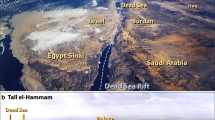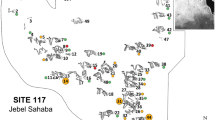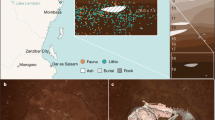The eruption's first surge instantly killed some people sheltering from the impact.
Abstract
The town of Herculaneum, lying at the foot of Mount Vesuvius on a cliff overlooking the sea, was buried by a succession of pyroclastic surges and flows (currents of volcanic ash and hot gases generated by collapse of the eruptive column) during the plinian eruption of ad 79. The skeletons of 80 of 300 people who had taken refuge in 12 boat chambers along the beach have now been unearthed from the first surge deposit. We have investigated how these people were killed by this surge, despite being sheltered from direct impact, after its abrupt collapse (emplacement) at about 500 °C on the beach. The victims' postures indicate that they died instantly, suggesting that the cause of death was thermally induced fulminant shock1 and not suffocation, which is believed to have killed many of the inhabitants of Pompeii and of Herculaneum itself.
This is a preview of subscription content, access via your institution
Access options
Subscribe to this journal
Receive 51 print issues and online access
$199.00 per year
only $3.90 per issue
Buy this article
- Purchase on Springer Link
- Instant access to full article PDF
Prices may be subject to local taxes which are calculated during checkout

Similar content being viewed by others
References
Brinkmann, B. et al. Rechtsmedizin 83, 1–16 (1979).
Carey, S. & Sigurdsson, H. Geol. Soc. Am. Bull. 99, 303–314 (1987).
Bohnert, M. et al. Forensic Sci. Int. 87, 55–62 (1997).
Bohnert, M., Rost, T. & Pollak, S. Forensic Sci. Int. 95, 11–21 (1998).
Yamamoto, K. et al. Bull. Kanagawa Dent. Coll. 18, 55–61 (1990).
Holden, J. L., Phakey, P. P. & Clement, J. G. Forensic Sci. Int. 74, 17–28 (1995).
Holck, P. thesis, Anatomical Institute, Univ. Oslo (1986).
Shipman, P., Foster, G. & Schoeninger, M. J. Archaeol.Sci. 11, 307–325 (1984).
LaMotte, R. H. & Campbell, J. N. J. Neurophysiol. 41, 509–528 (1978).
Baxter, P. J. Bull. Volcanol. 52, 532–544 (1990).
Butler, R. F. in Paleomagnetism 319 (Blackwell, Boston, 1992).
Author information
Authors and Affiliations
Corresponding author
Rights and permissions
About this article
Cite this article
Mastrolorenzo, G., Petrone, P., Pagano, M. et al. Herculaneum victims of Vesuvius in ad 79. Nature 410, 769–770 (2001). https://doi.org/10.1038/35071167
Issue Date:
DOI: https://doi.org/10.1038/35071167
This article is cited by
-
A new hazard scenario at Vesuvius: deadly thermal impact of detached ash cloud surges in 79CE at Herculaneum
Scientific Reports (2023)
-
Molecular signatures written in bone proteins of 79 AD victims from Herculaneum and Pompeii
Scientific Reports (2022)
-
The impact of pyroclastic density currents duration on humans: the case of the AD 79 eruption of Vesuvius
Scientific Reports (2021)
-
Taphonomic Study of a Modern Baboon Sleeping Site at Misgrot, South Africa: Implications for Large-Bodied Primate Taphonomy in Karstic Deposits
Journal of Paleolithic Archaeology (2021)
-
Multiphase flow behaviour and hazard prediction of pyroclastic density currents
Nature Reviews Earth & Environment (2020)
Comments
By submitting a comment you agree to abide by our Terms and Community Guidelines. If you find something abusive or that does not comply with our terms or guidelines please flag it as inappropriate.



